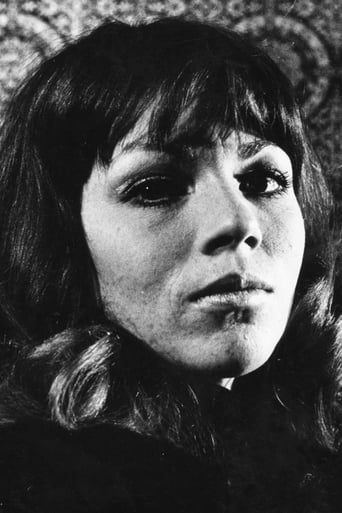2hotFeature
one of my absolute favorites!
Organnall
Too much about the plot just didn't add up, the writing was bad, some of the scenes were cringey and awkward,
Teddie Blake
The movie turns out to be a little better than the average. Starting from a romantic formula often seen in the cinema, it ends in the most predictable (and somewhat bland) way.
Ginger
Very good movie overall, highly recommended. Most of the negative reviews don't have any merit and are all pollitically based. Give this movie a chance at least, and it might give you a different perspective.
badidosh
Like the items from the menu of its titular establishment, "Kamome Diner" may be deceptively simple, yet within it is an amusing and sometimes hilarious contemplation on living in a foreign land, accompanied by droll performances and oozing sincerity so keen to please it would be churlish to fully dismiss. Naoki Ogigami's travelogue-slash-food show revels so much in its simplicity and oddity it's to the writer-director's credit that she succeeds on pulling it off with a material that sometimes border on sheer kink.Sachie (Satomi Kobayashi) solely runs Kamome Diner (Ruokala Lokki), a restaurant in Helsinki she envisions catering to Finns looking for other than the typical Japanese fare -- a dream that, judging from the perpetually empty tables and chairs, is getting a cruel disappointment. Never getting more than curious stares from passersby, wheels of change start turning soon, however, with Sachie's first customer, an apparent Japanophile (Jarkko Niemi) whose eagerness to start up a small talk with her paves the way to meeting with Midori (Hairi Katagiri), a Japanese woman who is in Finland, as she explains in one of the film's most comical moments, by blind luck. Midori strikes a friendship with Sachie and helps in maintaining the diner, which gradually sees patrons trickle in even as Sachie develops a bond with some of the restaurant's customers.Essentially a dissertation on the Maslowian hierarchy, Ogigami incrementally surrounds her characters with the core components for the survival of man (or woman, for that matter) by having them realize first the significance of basic necessities (the need to earn, the need for lodging, the need to find a lost luggage, etc) before they learn the value of peripheral essentials such as the camaraderie among themselves and the eventual self-actualization of Sachie as a restaurateur. The warm cinematography by Tuomo Virtanen lends a homey feel to the quaint diner -- a rather cramped but cozy place in the otherwise large but damp Finnish capital -- that furthers the empathetic kinship within its walls, a pleasing, if not perfect, marriage of the hospitable Japanese and the laid back Finn.
Tor Lillqvist
I found the film a bit boring and to tell the truth, fell asleep watching it on DVD a lazy Sunday afternoon.I found the acting especially by the young Finnish guy and the middle-aged Finnish woman less than convincing. Especially the "Koskenkorva" episode was a bit unrealistic, why would a woman who is depressed after losing her lover (or whatever the reason was) step into an empty diner, which doesn't at all look like it would even serve alcohol, and ask for a drink of vodka?But anyway, I just wanted to point out the careful selection of older and newer Finnish design classics used in the film. Aalto tables and chairs in the diner, the interiors of the Aalto-designed Academic Bookstore, Antti Nurmesniemi's coffee pots, the Hackman Tools series of pots and pans, Moomin books, and of course Marimekko clothes. Just to mention those I recognized before falling asleep.
DICK STEEL
This is Naoko Ogigami's third feature film, and the first Japanese film to be shot entirely in Finland, land of the midnight sun. As I mentioned in some other postings, cinema allows you to be transported to fantasy worlds, and of course in a more realistic sense, going to countries we have yet to set foot upon.The movie is set around a Japanese diner in Finland, and its owner, Sachie (Satomi Kobayashi). The story revolves around the diner, as well as the friendships that Sachie develops, with customer and crew. The food, "soul foods" as in the menu, can make anyone salivate and feel hunger pangs, especially when the movie was screened into dinner time.Pretty nothing much happens in Kamome Diner, except that there are plenty of people flitting in and out of the eatery. It's like watching a television series with episodes strung together, each putting the focus and theme on guest characters of the show, how they interact with the established leads. We are introduced to Sachie's first customer, a Finnish teenager who enjoys Japanese anime, and from there, one thing leads to another, as Sachie meets up with Midori (Hairi Katagiri), also another Japanese who left Japan to seek her fortunes in a strange land.The customers in the diner is set up in the story such that it's directly proportionate to the friendships established by Sachie. It's like a vicious circle being broken, with the seizing of opportunities and the chance of befriending a customer, comes the breaking down of hesitation that others have about something that is new, something less seen, something different. And as it grows, so too does the number of friendships being formed, nurtured and developed, akin to the care put into the creation of recipes and the cooking of food.By the end of it, everyone had undergone changes in their lives for the better, through subtle interactions, lessons learnt, and all these in a rather mundane manner of living life, in normal day to day activities.The cast is a mix of Japanese and Finnish, and the dialogue too a mix of languages. But given its themes of friendship, belief, keeping the faith and being positive just about everything, it's ultimately a feel good movie, with plenty of subtleties, a dash of humour, and generous servings of well intentions.
kargokultti-1
I agree with the previous commenter, that on some level, this was an empty film. But I don't see this as a bad thing: the lack of content can be just as meaningful as the glut of it. Personally, I prefer emptiness: it leaves more room for your own thoughts.But I wouldn't criticize this movie on its illogicalities (yes, that's a word - at least from now on): there's some very clear surrealist tendencies in the story, and it seems to me that surrealism and logic mix together just about as well as water and oil would.All in all, I think this film is modest and well made, and even though it mightn't end up as an eternally bright beacon in the vast steppes of the cinematic arts, it sucker-punches the hell out of films that aim to be bigger and more important, but end up being useless fluff.




